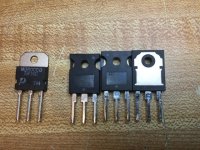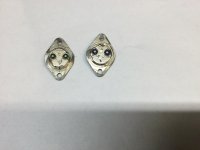minek - If you are convinced that these transistors are BEC I'd send a sample to ST and ask them to investigate letting them (copy Mouser) know where/when bought out of formality, as wg_ski says. The reputable manufacturers take rip-off "cloning" seriously.
I'm 100% convinced they are B-E-C.minek - If you are convinced that these transistors are BEC I'd send a sample to ST and ask them to investigate letting them (copy Mouser) know where/when bought out of formality, as wg_ski says. The reputable manufacturers take rip-off "cloning" seriously.
I explained everything to them, sent them photos, they said they will investigate, but they didn't ask to send them these devices back..
My bet is they already knew about it, I can't be the only one getting them. They are frequently on backorder, so they are popular..
Not sure how serious they are.
+1Did you measure the connectivity between the centre lead and tab?
Asking for measurements here is like pulling teeth.
I don´t care about what a microprocessed device screen shows, way too many unknown variables in the middle, just what does a plain old simple diode meter show?
A 200 ohm scale reading between center leg and tab/back plate?
Takes all of 15 seconds.
Incredibly experienced Tech Enzo always said: "never search for excuses NOT to measure something".
Center pin is connected the tab: 0.4 Ohm (both ways).
I don't know how other transistors are built (e.g. laterals that have emitter as center pin),
but with all power BJTs I've seen opened, center pin is a part of the tab - mechanically.
It's the same piece of metal shaped like a tab with extended pin/leg, so I would not expect
different result from a BJT device.
I'm going to open one of them tomorrow, and have a closer look., perhaps open genuine one and compare.
I don't know how other transistors are built (e.g. laterals that have emitter as center pin),
but with all power BJTs I've seen opened, center pin is a part of the tab - mechanically.
It's the same piece of metal shaped like a tab with extended pin/leg, so I would not expect
different result from a BJT device.
I'm going to open one of them tomorrow, and have a closer look., perhaps open genuine one and compare.
Last edited:
They behaved differently (i would say 'incorrectly') in the actual circuit.
That's why i proceeded with further testing
That's why i proceeded with further testing
Modern Silicon pretty-reliably has B-E breakdown near 7V. I believe that doping also gives best beta. OTOH the C-B junction can be 12V and up and up. If you find a 7V breakdown, that's a big clue.I wonder how that tester decides which lead is which.
At intended currents, 'reverse hFE' is 1 to 10 while forward hFE is (at intended currents) 10 or more, often much more.
Thanks.Center pin is connected the tab: 0.4 Ohm (both ways).
I don't know how other transistors are built (e.g. laterals that have emitter as center pin),
but with all power BJTs I've seen opened, center pin is a part of the tab - mechanically.
It's the same piece of metal shaped like a tab with extended pin/leg, so I would not expect
different result from a BJT device.
I'm going to open one of them tomorrow, and have a closer look., perhaps open genuine one and compare.
That´s what we all were expecting, instead of "I'm 100% convinced they are B-E-C."
I guess opening them will confirm this too, what else? but please do.
Same here.So I wonder how that tester decides which lead is which.
In principle, there is some decision taken by Software designer, which is not visible to us.
That´s why in case of doubt I "downgrade" to basic meter "hand readings", not much wiggle space around that.
At much lower than intended currents reverse hFE could be 10 and forward could be 5. As you increase the current, reverse won’t go up but forward will. It is unusual for reverse hFE to be that high, but not impossible. If the transistor IS out of whack anything can happen. Breakdown is telling - EB won’t be higher than about 15. Ratings are usually 5 to 7, but in practice about 13 is what you physically get. Even a piece of junk will do better than 25 CB - bottom of the barrel epi-base (before grading at the factory) will give you 40.
The collector will always be tied to the tab. The BACKSIDE of the die is the collector. You have to use a special non conductive die attach otherwise. Mosfets can be processed with the SOURCE (emitter) as backside so they can be connected otherwise for laterals, but on hexfets you’re stuck with the body diode. Note which direction the body diode is connected on a typical hexfet - that tells you the direction it really “wants” to be intrinsically. That parasitic diode is always there, and it’s cathode corresponds to the collector of a bipolar.
The collector will always be tied to the tab. The BACKSIDE of the die is the collector. You have to use a special non conductive die attach otherwise. Mosfets can be processed with the SOURCE (emitter) as backside so they can be connected otherwise for laterals, but on hexfets you’re stuck with the body diode. Note which direction the body diode is connected on a typical hexfet - that tells you the direction it really “wants” to be intrinsically. That parasitic diode is always there, and it’s cathode corresponds to the collector of a bipolar.
Got more TIP2955 transistors from Newark.com and Digikey.
On this photo: the one on the left is from Mouser (STI) - fake or damaged (don't work in the tester and in actual circuit);
the two on the right : TO-218 STI (Digikey), and the other one Multicomp (Newark)) - working perfectly in the tester and in the actual circuit.
So far I used these Moroccan ones in 2 amps, and they work perfectly. Must be some old stock I guess....

On this photo: the one on the left is from Mouser (STI) - fake or damaged (don't work in the tester and in actual circuit);
the two on the right : TO-218 STI (Digikey), and the other one Multicomp (Newark)) - working perfectly in the tester and in the actual circuit.
So far I used these Moroccan ones in 2 amps, and they work perfectly. Must be some old stock I guess....
Good faith errors sometimes happen: I remember that ~35 years ago, we received a 10k shipment of BC548 from Motorola and they had the pinout reversed: US-like, not European. They were replaced without problem, and they offered their excuses.
In this case, it is probably a fake issue: they could be P-darlingtons rejects. This could explain the behaviour: they have integral B-E resistors, and their threshold is 2*Vbe, meaning the apparent Hfe in the normal configuration is very low for a simple tester.
In this case, it is probably a fake issue: they could be P-darlingtons rejects. This could explain the behaviour: they have integral B-E resistors, and their threshold is 2*Vbe, meaning the apparent Hfe in the normal configuration is very low for a simple tester.
The ones on the right are rare-ish metal tab ones, grab a few more while they last.
The left one has printing inside a glossy pocket, the font is correct, check the data sheet for the cut-out design and dimensions, as traders can tell fakes apart at a glance, I did never ask them how, maybe the overall feel and look.
Getting them from a reputed source is worrisome.
The left one has printing inside a glossy pocket, the font is correct, check the data sheet for the cut-out design and dimensions, as traders can tell fakes apart at a glance, I did never ask them how, maybe the overall feel and look.
Getting them from a reputed source is worrisome.
They haven‘t made that TO-218 in over a decade (Note the 1996 date code). I’m surprised Digikey still had any of them. I can still find them from surplus dealers occasionally. Last ones were clearly STs, re-badged for some second source. Didn’t recognize the logo, but had the Morocco origin code. Measured and worked fine. In with the same batch we’re some TO-247’s with the more modern MAR origin code. They measured identical.
TIPs I got from Mouser recently with the China code on them measured somewhat different. Over 2X increase in capacitance, indicative of a larger die. Higher hFE, too. The lead frames of the modern CHN and MAR coded devices look exactly the same (see the back).
The ones in the center in post 51 are Mospec - which makes good copies of most of the obsolete 2N devices. I’ve gotten a number of their TO-3’s and haven’t found anything wrong with them. They had the white goo inside, but a full size die, mounted at a 45 degree angle, with a proper copper heat spreader coin. And took a hacksaw to open - the lids have proper hermetic seal.
TIPs I got from Mouser recently with the China code on them measured somewhat different. Over 2X increase in capacitance, indicative of a larger die. Higher hFE, too. The lead frames of the modern CHN and MAR coded devices look exactly the same (see the back).
The ones in the center in post 51 are Mospec - which makes good copies of most of the obsolete 2N devices. I’ve gotten a number of their TO-3’s and haven’t found anything wrong with them. They had the white goo inside, but a full size die, mounted at a 45 degree angle, with a proper copper heat spreader coin. And took a hacksaw to open - the lids have proper hermetic seal.
Attachments
That's the bad/fake one from Mouser.
I didn't open any good ones, so have nothing to compare with...
Still meant to be a 15A transistor with a 15A emitter bond wire. That sets lower limits on die size
- Home
- Design & Build
- Parts
- Fake TIP2955 from Mouser?

